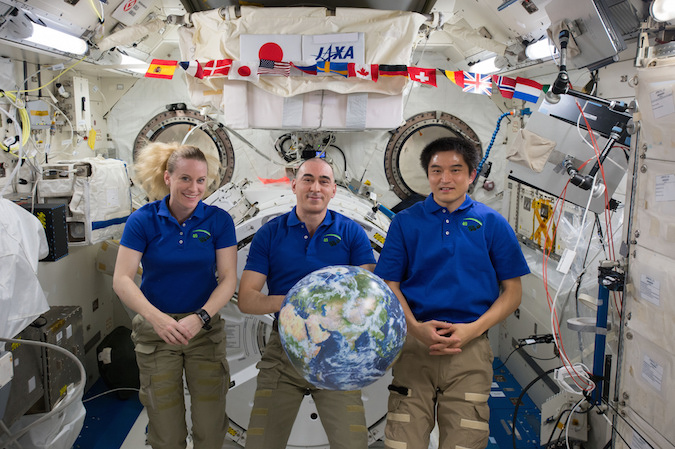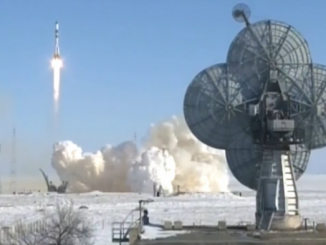STORY WRITTEN FOR CBS NEWS & USED WITH PERMISSION

In a rapid-fire crew rotation, a NASA astronaut and two Russian cosmonauts are packing up for the trip back to Earth Saturday, leaving the International Space Station just eight days after the arrival of another three-person crew and three weeks before their own replacements arrive to boost the lab’s crew back to six.
Soyuz MS-01 commander Anatoly Ivanishin, Japanese astronaut Takuya Onishi and NASA scientist-astronaut Kate Rubins plan to undock from the station’s Rassvet module at 8:35 p.m. EDT (GMT-4) Saturday.
After moving a safe distance away, Ivanishin plans to oversee a precisely calculated four-minute 37-second rocket firing starting at 11:06 p.m., slowing the ship’s 17,000-mph orbital velocity by about 286 mph, just enough to drop the far side of the orbit deep into the atmosphere.
If all goes well, the central crew module will slam into the discernible atmosphere at an altitude of 62 miles at 11:36 p.m., leading to a parachute-and-rocket-assisted touchdown on the steppe of Kazakhstan southeast of Dzhezkazgan at 11:59 p.m. (9:59 a.m. Sunday local time). Forecasters are predicting chilly weather with low clouds and temperatures around 30 degrees Fahrenheit.
Left behind in orbit will be Expedition 50 commander Shane Kimbrough, Sergey Ryzhikov and Andrey Borisenko, who reached the outpost on Oct. 21 aboard the Soyuz TMA-02 spacecraft.
They will have the station to themselves until Nov. 19 when three fresh crew members — Soyuz MS-03 commander Oleg Novitskiy, European Space Agency flight engineer Thomas Pesquet and veteran NASA astronaut Peggy Whitson — arrive two days after their own launch from Baikonur.
As with all Soyuz landings, Russian recovery crews, flight surgeons and NASA personnel deployed nearby will be on hand within minutes of touchdown to assist Ivanishin, Onishi and Rubins out of the cramped descent module as they begin their readjustment to Earth’s gravity after 115 days in space.
At touchdown, Ivanishin’s total time in space over two station missions will stand at 280 days. Rubins and Onishi will have logged 115 days off planet during their first space flight.
After brief medical checks and satellite phone calls home to friends and family, all three crew members were scheduled to be flown to nearby Karaganda for a traditional Kazakh welcome home ceremony. From there, Ivanishin will be flown back to Star City near Moscow while Rubins and Onishi board a NASA jet for the long flight back to the Johnson Space Center in Houston.
Kimbrough’s crew originally was expected to join Rubins and her crewmates in September, but the last-minute discovery of a wiring problem in the Soyuz MS-02 spacecraft forced a delay for complex repairs. Russian planners opted not to extend the MS-01 mission and to bring Ivanishin and company back to Earth on schedule.
Over the course of their mission, Ivanishin, Rubins and Onishi will have completed 1,840 orbits and traveled 48.7 million miles. They helped unload a Russian Progress cargo ship, a SpaceX Dragon freighter and an Orbital ATK Cygnus supply ship. They also helped an earlier crew depart and welcomed Kimbrough and company to the station.
Rubins, a virologist who has a doctorate in cancer biology, carried out a variety of experiments during her stay in space, including the first DNA sequencing in orbit. DNA sequencing determines the exact order of the four nucleotides making up a DNA molecule — adenine, guanine, cytosine and thymine — information critical in a variety of disciplines.
“This is truly an experiment in all senses of the word,” Rubins said in a chat earlier this month with Francis Collins, director of the National Institutes of Health. “We did not know if it was going to work the first time we did sequencing in space.”
But it did work, and “it actually was a fantastic technology demonstration,” Rubins said. “We were able to show that we can successfully do sequencing in space. We’ve sequenced over a billion base pairs at this point. So we have this capability now in low-Earth orbit.”
She said DNA sequencing could be used to better understand the “microbiome” aboard the space station, where the crew’s air and water are constantly recycled, as well as helping gain a better understanding of human health in general.
“We can also use this technology when we’re starting to look for signs of life in the solar system,” Rubins said. “And we can also start to understand human health and disease (in space). Most of our disease research is taking a variable and looking at human physiology under different conditions. We have the opportunity to look at human physiology as it’s floating here. This is obviously quite a unique laboratory.”
In addition to her research, Rubins carried out two spacewalks with Expedition 48 commander Jeff Williams, spending a total of 12 hours and 46 minutes outside the station to help attach and connect a new docking port on the front of the lab complex that will be used by commercial crew ferry ships being built by Boeing and SpaceX.
Rubins, Onishi and Kimbrough originally expected to carry out spacewalks in October to replace 12 aging nickel-hydrogen batteries in the station’s solar power system with six smaller, more powerful lithium-ion batteries.
But delivery of the new batteries aboard a Japanese HTV cargo ship was delayed to Dec. 9 after problems with the spacecraft’s propulsion system were discovered.
As it now stands, the new batteries will be installed in January. Whitson, Kimbrough and Pesquet are all trained for the repair work, but NASA has not yet decided who will go outside.



